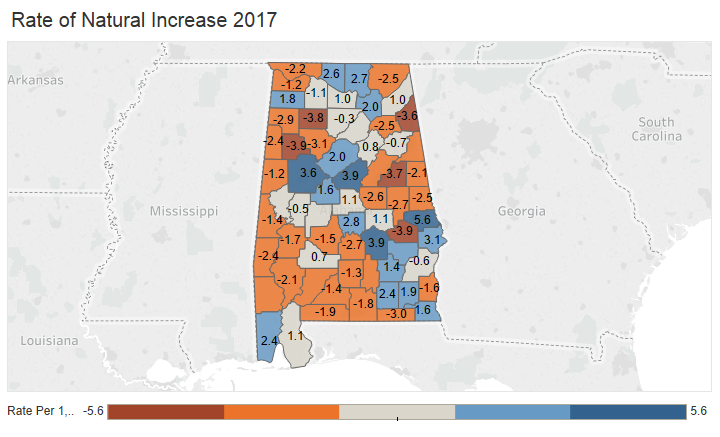
As a follow-up to PARCA’s previous post on estimated changes to Alabama’s population in comparison to other states, we now present recent U.S. Census estimates of population change in Alabama counties and metro areas.
As a state, Alabama’s population has increased 2 percent since 2010, a faster rate of growth than Mississippi, but slower than other Southeastern states. A closer look, examining population change at the county level, reveals a wide disparity between the population growth rates within the state, with 45 of Alabama’s 67 counties experiencing population loss between 2010 and 2017, according to the Census estimates.
Rural counties in Central Alabama, particularly in Alabama’s Black Belt have experienced the greatest losses in percentage terms. The steepest loss was Macon County, which has experienced a 12.6 percent population decline since 2010, according to the estimates. Dallas County has lost the greatest number of residents over the time period, with the estimated population dropping by 4,605.
Meanwhile, in percentage terms, the strongest growth over the course of the decade is occurring in coastal Baldwin County and in Lee County, home to Auburn University.
The Huntsville area counties of Madison and Limestone counties are continuing to grow at a rapid pace, as are the suburban counties around Birmingham. Tuscaloosa County also continues to grow. Suburban counties around Montgomery are growing but at a slightly slower pace. Houston and Coffee counties, in the Wiregrass region, are also seeing moderate growth.
As for the state’s largest counties, Jefferson County and Mobile counties are seeing minimal growth while Montgomery County is losing population, according to the estimates.
Looking at the estimates for the most recent year, 2016-2017, there appears to have been positive population growth in most of the counties bordering Georgia.
Examining the components of change, the central counties of the three largest metro areas, Jefferson, Montgomery, and Mobile, are losing large numbers of residents through domestic migration. Residents of the central counties moving to suburban counties or elsewhere in the U.S.
That population loss in the central counties is offset by the natural increase in those counties and by international in-migration. Tuscaloosa, Lee, and Madison counties are also seeing population gains through international in-migration. Much of the rest of the state, particularly rural counties, have received little in terms of international in-migration.
In 40 out of the 67 Alabama counties, the number of deaths outnumbers the number of births, leading to a negative rate of natural increase. Counties where deaths outnumber births tend to have an aging population and low levels of population in-flow. Poorer health in those counties may also contribute to higher rates of death.
When looking at population change at the metropolitan level, the Birmingham-Hoover metro area is seeing modest growth. Mobile County, which is its own metro area, has grown only slightly since 2010, but neighboring Baldwin County, a separate MSA officially called the Daphne-Fairhope-Foley MSA, is the Alabama’s fastest growing in percentage terms (16.7 percent growth since 2010) and is second to the Huntsville MSA in numeric growth over the period.
Looking at the bigger picture, the visualization below allows you to compare rates of population change across all the metropolitan statistical areas in the U.S. It is worth noting that despite, Alabama’s slow growth overall, the Auburn-Opelika and Daphne-Fairhope-Foley MSA rank in the top 20 of the U.S. in terms of percentage growth. With the exception of Huntsville, which ranks 75th in terms of percentage growth since 2010, Alabama’s major metros, Birmingham, Mobile, and Montgomery, are growing more slowly than major MSAs in Florida, Georgia, and the Carolinas.
